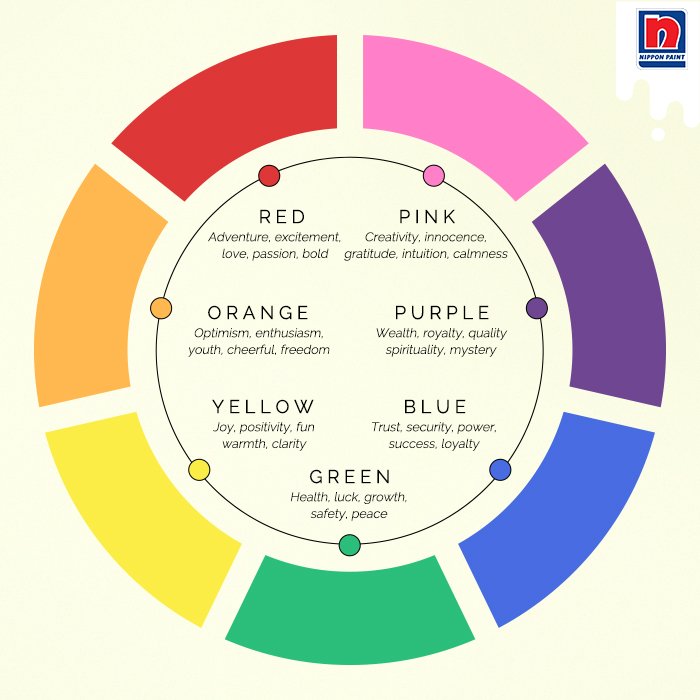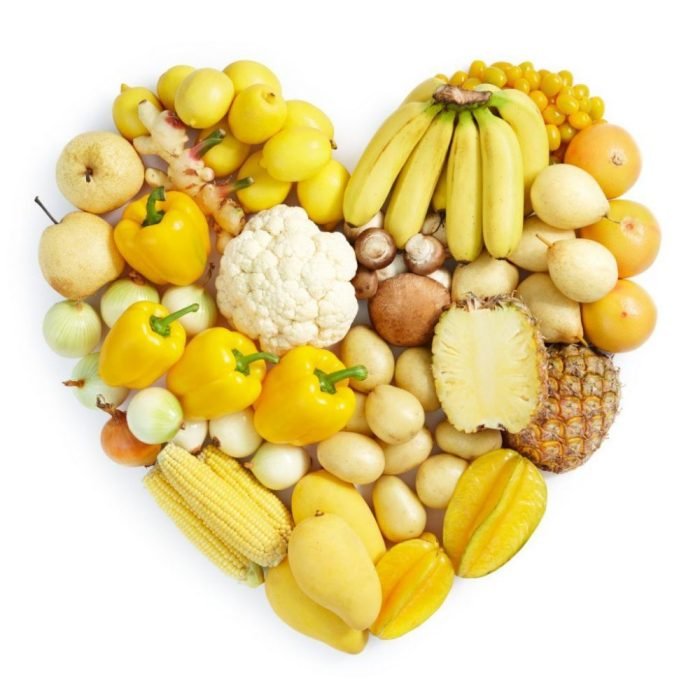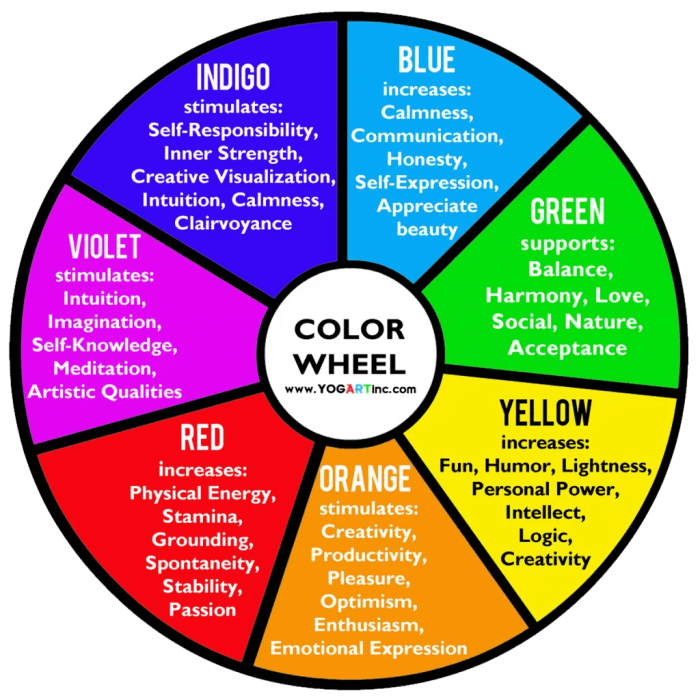Health in Color takes center stage, exploring the fascinating relationship between hues and our well-being. From the impact of color on mood and emotions to its role in healthcare environments and nutritional choices, this exploration delves into the subtle yet powerful ways color influences our lives.
This journey unveils how colors can affect our perceptions, promote healing, and even shape our eating habits. We’ll uncover the psychology behind color therapy, examine the use of color in healthcare design, and explore the connection between color and nutrition.
Prepare to discover how color can be a powerful tool for enhancing our physical, mental, and emotional health.
The Psychology of Color and Health

The human brain is wired to respond to color in a way that influences mood, emotions, and even physical health. Color psychology explores the complex relationship between color and human behavior, delving into how different hues can impact our perception of the world and our well-being.
Impact of Color on Mood and Emotions
Color plays a significant role in shaping our emotional landscape. Different colors evoke distinct feelings and associations, influencing our mood and overall emotional state.
- Blueis often associated with calmness, peace, and tranquility. It can have a soothing effect on the mind and body, reducing stress and anxiety. Studies have shown that blue environments can promote relaxation and improve sleep quality.
- Greenrepresents nature, growth, and renewal. It is linked to feelings of balance, harmony, and vitality. Green can have a calming effect similar to blue, while also stimulating creativity and promoting a sense of well-being.
- Yellowis associated with optimism, happiness, and energy. It can uplift mood and boost creativity, but excessive exposure to yellow can be overwhelming and lead to feelings of agitation.
- Redis a stimulating color linked to passion, excitement, and energy. It can increase heart rate and blood pressure, making it an energizing color but potentially overwhelming for some individuals.
- Orangeis a vibrant color that evokes feelings of warmth, enthusiasm, and creativity. It can boost energy levels and stimulate appetite.
- Purpleis associated with royalty, spirituality, and luxury. It can promote calmness and introspection, while also inspiring creativity and imagination.
Color in Healthcare Environments: Health In Color

The strategic use of color in healthcare settings is not just about aesthetics; it plays a crucial role in influencing patient well-being, staff morale, and overall hospital efficiency. Color psychology suggests that certain hues can evoke specific emotions and physiological responses, impacting patient recovery, stress levels, and even pain perception.
Color Palettes in Medical Specialties
The choice of color palettes in healthcare spaces often reflects the specific needs and ambiance of different medical specialties. Here are some examples:
- Pediatric Wards:Vibrant colors like yellows, greens, and blues are frequently used in pediatric wards to create a cheerful and stimulating environment. These colors are associated with playfulness, creativity, and a sense of optimism, which can help to alleviate anxiety and promote a sense of comfort in young patients.
- Cardiac Care Units:Calming colors such as light blues, greens, and lavender are often preferred in cardiac care units to create a serene and relaxing atmosphere. These hues can help to lower blood pressure, reduce stress, and promote a sense of tranquility, which is beneficial for patients recovering from heart-related illnesses.
- Mental Health Units:Warm colors like yellows and oranges can be used in mental health units to evoke feelings of warmth, optimism, and energy. These colors can help to create a welcoming and supportive environment, fostering a sense of hope and promoting a positive outlook in patients.
Color and Nutrition

Color plays a significant role in our perception of food, influencing our choices and even our health. The vibrant hues of fruits and vegetables are not just aesthetically pleasing; they are nature’s way of signaling the presence of essential nutrients.
The Role of Color in Food
The colors of food are often associated with specific nutrients. For example, red fruits and vegetables are rich in lycopene, an antioxidant linked to heart health. Orange fruits and vegetables, on the other hand, are known for their high levels of beta-carotene, a precursor to vitamin A, essential for vision.
By understanding the nutritional value associated with different colors, we can make more informed food choices to support our overall well-being.
The concept of “health in color” often focuses on the vibrant hues of fruits and vegetables, highlighting their nutritional value. However, simplicity in health can be just as powerful. Simplicity health emphasizes the importance of uncomplicated lifestyle choices that promote well-being, such as getting enough sleep, staying hydrated, and managing stress.
These simple practices, when combined with a colorful diet, can significantly contribute to overall health and vitality.
Color and Appetite
Color can significantly influence our appetite and food choices. Studies have shown that vibrant colors, such as red and yellow, can stimulate appetite and increase food intake. This is because these colors are associated with ripeness and sweetness, triggering our natural desire for these qualities.
Conversely, muted colors like brown and gray can suppress appetite, as they are often associated with bland or unappealing flavors.
Health Benefits of Different Food Colors
The color of food is a valuable indicator of its nutritional content. Here’s a table showcasing the health benefits associated with different food colors:
| Color | Benefits |
|---|---|
| Red | Heart health, energy boost, blood pressure regulation |
| Orange | Immune system support, vision health, skin health |
| Yellow | Brain function, mood enhancement, digestive health |
| Green | Detoxification, bone health, blood sugar regulation |
| Blue/Purple | Anti-inflammatory properties, cognitive function, cardiovascular health |
Color in Wellness Practices

Color has long been recognized for its ability to influence mood, emotions, and even physical well-being. In wellness practices, color is often used to enhance relaxation, promote healing, and support overall well-being.
Color in Aromatherapy
Aromatherapy is a holistic practice that uses essential oils derived from plants to promote physical and emotional well-being. The colors of essential oils are often associated with their specific properties and effects. For example, lavender oil, often associated with a calming purple hue, is known for its relaxing and stress-reducing properties.
The connection between health and color is fascinating, with different hues impacting our mood and well-being. For instance, the calming blue of a tranquil river can be reminiscent of the serene environment at the River People Health Center , a place designed to promote holistic healing.
By incorporating color therapy into their approach, they strive to create a positive and supportive atmosphere for their patients.
- Blue essential oils, such as chamomile and eucalyptus, are often used to soothe anxiety, promote relaxation, and calm the mind.
- Green essential oils, such as peppermint and rosemary, are believed to boost energy levels, improve focus, and promote clarity.
- Yellow essential oils, such as lemon and grapefruit, are often used to uplift mood, increase energy, and promote feelings of joy.
By incorporating color into aromatherapy practices, practitioners can enhance the therapeutic effects of essential oils and create a more immersive and meaningful experience.
Health in color is a fascinating concept, showcasing how different foods offer unique benefits. The vibrant purple hue of eggplant, for example, is a testament to its rich antioxidant content. You can learn more about the benefits of eggplant for health , from boosting heart health to aiding in weight management.
This delicious and versatile vegetable is a great example of how color can be a guide to a healthier lifestyle.
Color in Meditation and Mindfulness
Meditation and mindfulness practices involve focusing the mind on the present moment, cultivating awareness, and reducing stress. Color can play a significant role in these practices by influencing the mood and creating a conducive environment for relaxation and focus.
- Blue, often associated with tranquility and peace, can help to calm the mind and promote relaxation.
- Green, representing nature and growth, can foster feelings of grounding and stability, promoting a sense of connection to the earth.
- Red, a stimulating color, can be used to enhance energy levels and boost motivation during meditation sessions.
Using color in meditation and mindfulness practices can enhance the overall experience, creating a more immersive and effective approach to achieving inner peace and well-being.
Color and Chakras
In ancient Indian philosophy, chakras are energy centers within the body that are believed to influence physical, emotional, and spiritual well-being. Each chakra is associated with a specific color, and balancing these energy centers through various practices, including meditation and yoga, is thought to promote overall health and harmony.
A visual guide illustrating the connection between different colors and their corresponding chakras can be a powerful tool for understanding and working with these energy centers.
- Root Chakra (Muladhara):Red, located at the base of the spine, associated with grounding, security, and survival instincts.
- Sacral Chakra (Svadhisthana):Orange, located in the lower abdomen, associated with creativity, emotions, and sexuality.
- Solar Plexus Chakra (Manipura):Yellow, located in the upper abdomen, associated with self-esteem, willpower, and personal power.
- Heart Chakra (Anahata):Green, located in the center of the chest, associated with love, compassion, and emotional balance.
- Throat Chakra (Vishuddha):Blue, located in the throat, associated with communication, self-expression, and truth.
- Third Eye Chakra (Ajna):Indigo, located between the eyebrows, associated with intuition, wisdom, and psychic abilities.
- Crown Chakra (Sahasrara):Violet, located at the top of the head, associated with spiritual connection, enlightenment, and universal consciousness.
By understanding the colors associated with each chakra, individuals can use color visualization techniques during meditation or yoga to balance and harmonize these energy centers, promoting overall well-being.
Color and Personal Health

Color can be a powerful tool for improving overall well-being. By incorporating color into our daily lives, we can influence our mood, sleep patterns, and energy levels.
Color and Sleep Patterns
The color of our surroundings can significantly impact our sleep quality. Blue light, often emitted from electronic devices, can suppress the production of melatonin, a hormone that regulates sleep. Exposure to blue light in the evening can make it harder to fall asleep and disrupt our sleep cycle.
To improve sleep, consider incorporating calming colors like blue, green, and lavender into your bedroom. These colors have a calming effect and can promote relaxation.
Color and Energy Levels
Color can also affect our energy levels. Bright colors like yellow, orange, and red can stimulate the nervous system and boost energy levels. These colors are often used in workplaces to promote focus and productivity. Conversely, calming colors like blue, green, and purple can have a relaxing effect and can help to reduce stress and anxiety.
Creating a Calming Environment
To create a more calming environment, consider incorporating cool colors like blue, green, and purple. These colors can help to reduce stress, promote relaxation, and create a sense of peace. For example, painting your bedroom walls a soft blue or green can help to create a soothing atmosphere that is conducive to sleep.
Adding green plants to your living space can also help to create a sense of calm and tranquility.
Creating a Stimulating Environment, Health in color
If you are looking to create a more stimulating environment, consider incorporating warm colors like yellow, orange, and red. These colors can boost energy levels, promote creativity, and enhance focus. For example, painting a home office in a bright yellow or orange can help to create a more stimulating environment that is conducive to work.
Adding red accents to a living room can also help to create a more energetic and vibrant atmosphere.
End of Discussion

As we conclude our exploration of Health in Color, we’re left with a deeper appreciation for the subtle yet profound influence of color on our lives. From promoting healing in healthcare settings to influencing our food choices and fostering inner peace, color offers a spectrum of possibilities for enhancing our well-being.
By incorporating color consciously into our daily lives, we can harness its power to create a more vibrant, harmonious, and healthy existence.
FAQ Section
What are some practical ways to incorporate color into my daily life for better well-being?
Start by surrounding yourself with colors that uplift your mood. Use calming blues and greens in your bedroom, energizing yellows and oranges in your workspace, and incorporate colors that resonate with you in your clothing and home décor.
Can color really affect my sleep patterns?
Yes, certain colors can influence sleep. Blue light, often emitted from electronic devices, can suppress melatonin production, making it harder to fall asleep. Opt for warm-toned lighting in the evening and avoid blue light exposure before bed.
How can I use color to create a more calming environment?
Choose calming colors like blues, greens, and purples for your home décor. Incorporate natural elements like plants and soft textures to further enhance a sense of peace and tranquility.